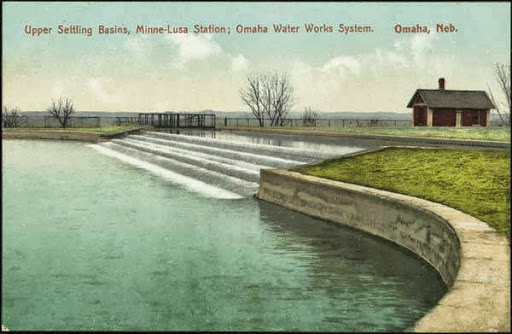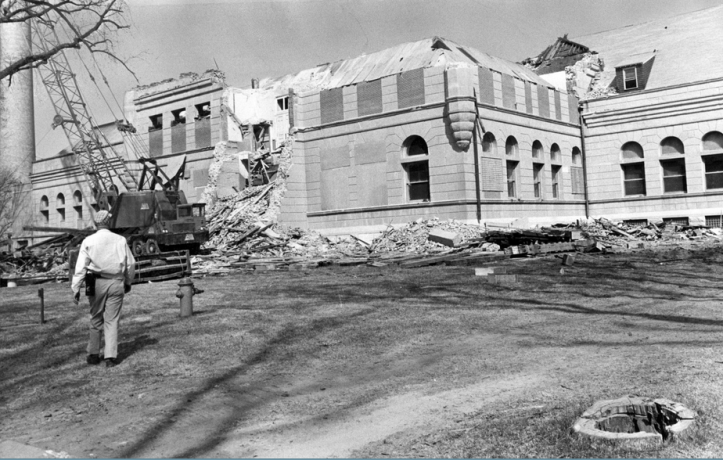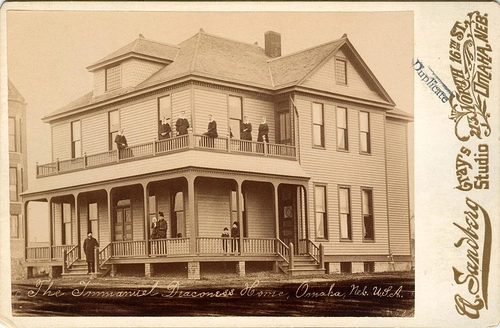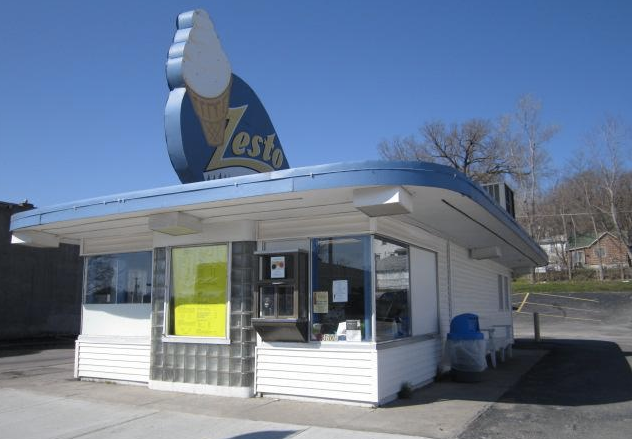The Florence Water Works was once home to one of the most magnificent buildings in the entire city of Omaha. After being nearly-obliterated in 1970, MUD has rebuilt the structure to honor its 130-year history, and today the water there keeps wetting the whistle. This is a history of the Florence Water Works and Minne Lusa Pumping Station.
Historical integrity includes the original facade and interiors of old buildings. It includes some semblance of sustained commitment to the well-being of structures. The story of the Minne Lusa Station at the MUD Florence Water Treatment Plant, aka the Florence Water Works, shows just how challenging it can be.
Throughout its whole history, the city of Omaha has renovated or demolished many historical buildings. In the 1950s, the city government wrecked the Old Post Office and the Old City Hall; in the 1970s, they razed housing throughout the city, especially ripping through North Omaha. During that decade, MUD nearly demolished the gigantic beauty of the Minne Lusa Pumping Station which had once graced the city’s northern fringes. Following is a history of the Florence Water Works including the Minne Lusa Pumping Station.
Early Water in Omaha

Omaha needed water. Originally pulling water from the Missouri River in downtown Omaha or pumping water from wells in their backyards, residents wanted cleaner, more consistent water for drinking, cleaning, and plumbing. Entrepreneurs stepped in.

The City Water Works Company was a private local company established in the late 1870s in Omaha. Their original water works was located on the Missouri River near North 6th and California Streets near the Winspear Triangle. However, with all of the cows and horses and ox and people to water throughout the growing burg, that facility quickly grew inadequate. Additionally, there was a booming population north of Dodge Street that was only going to grow more along with prospects for expansion to the west and south of downtown. The City Water Works Company was formed to make money from these new residents.

Land south of the city was quickly ruled out for a new waterworks because it was downstream from downtown, where industries of all kinds regularly polluted the Missouri River. Additionally, the cliffs separating useful land from the water were too restrictive. Land near downtown in Winspear and the North Omaha Bottoms was too susceptible to flooding and was proving less-than-useful. That left the northlands beyond East Omaha. Identifying Florence Lake as a useful but under-sized resource, the entrepreneurs and City leaders looked to the little village of Florence. The area offered the right composition of land height, soil type, land availability and growth potential, and the company bought it up.
Starting construction on a massive new water filtering system along John J. Pershing Drive just south of the present-day Mormon Bridge, the facility is about seven miles north of downtown. When it was finished in 1880, the Florence Water Works was seen as a marvel. With millions of gallons of capacity, the system drew water up a hundred foot cliff from the Missouri and filtered it through several large pools.
Building a Behemoth

The beauty of the Florence Water Works was immediately hailed for its beauty and grandeur when it was finished. Over the years, the spectacular vision of this northern institution only grew. When it was originally built, there were only settling pools in place, along with a few utility buildings.
There were bumps along the way. In 1887, the City Water Works Company defaulted on the loans that allowed them to build the water works. The company and its facilities were purchased by the American Water Works Company that year.

American operated private water companies in many cities, including South Omaha and Denver, and on the East Coast. They had ambitious plans, and when they bought the system, the American Water Works Company started construction on the Minne Lusa Pumping Station almost immediately. They hired an important architecture firm in Omaha in the late 19th century called Mendelssohn, Fisher and Lawrie, who designed the Minne Lusa Pumping Station. It was built between 1888 and 1889.
A Castle in Florence?

Named for a local creek that was later rerouted to the Missouri River at the north end of Minne Lusa Boulevard, the Minne Lusa Pumping Station was a beautiful, massive building made of Warrensburg sandstone. Sitting on five acres of landscaped park-like areas, the building featured a central tower rising four stories over an arched entryway, and housed a high service pump and huge boilers that filtered water flowed to the city water mains. Jim Dahlman, Omaha’s cowboy mayor, opened the station in a grand ceremony in August 1889.
Inside, the building felt enormous. It housed pumps used to churn the water through cleaning systems, and had plenty of large, open spaces that felt grand and important. Over the first few decades of the station, there were continual reports in the the society pages of Omaha’s newspaper about the superintendent hiring orchestras to play at elaborate dances held for the city’s upper crust. Taking a luxurious drive in elegant carriages along Florence Boulevard and the river road, these fancy guests marveled at the grand feats of engineering within and apparent in the building itself.

When guests arrived at the Minne Lusa Pumping Station, they were greeted by a large granite fountain inside a 12-foot-wide wading pool. Kids would routinely visit the fountain for refreshment, basking in streams from its three monster heads spurting water from their mouths, along with a large stream projecting into the air.
Birch trees lined the pathways at the waterworks, which made for pleasant strolling along the cool pools on hot summer evenings. The entire facility was a visage from Omaha’s high Victorian era, and a lot of people developed sentimental feelings about the place.
Construction Around the Waterworks

Originally built in the 1910s, the Missouri River Intakes were designed to draw water from the river and into the settling ponds at the Florence Water Works. Designed in a park-like fashion along the beautiful J.J. Pershing Drive overlooking the Missouri River, they were as regal at the City’s popular Walnut Hill Reservoir. Today, although they’re fenced in and off-limits to the public, they still serve the same purpose for MUD.

Living so far from Omaha, the American Water Works Company decided to build worker’s houses on the grounds of the Florence Water Works, too. In the early 1890s, they built at least eight large, two-story American Foursquare style architecture homes, including several bedrooms, full basements and wide front porches. Located north of the Minne Lusa Pumping Station, they sat on Hunt Street, and were connected to Main Street in Florence. Hunt Street doesn’t exist anymore.

There was also a mansion built for the superintendent of the facility. The homes were renowned for being large, plush environments guests liked to visit because of the beauty of the water works. The superintendent regularly played host to guests, and was frequently included in the city’s newspapers’ gossip and society columns.

In 1895, the facility was sold by the American Water Works to a local company called the Omaha Water Works. In addition to its water business there, the new company fostered the development of a railroad line to run next to the waterworks. Built by the Chicago, St. Paul, Minneapolis and Omaha Railway, aka the Omaha Road, the line ran from downtown Omaha north to the Florence Depot at North 28th and Tucker Street, immediately west of the works.

In addition to passenger traffic, the Florence Depot served as a loading point for the icehouse contracted by the Omaha Water Works sold ice and distributed it throughout the region. Built in the 1880s, the icehouse was run by David Talbot and ran for several years as the only icehouse in Omaha under the company named Reservoir Ice Company. Talbot was a wealthy man whose monopoly over the city’s ice industry stood for several years.
It is still in use today, with a different exterior. It was remodeled in the 1960’s to repair damage done by age and termites.
The Great Demolition

Over the following century, a lot changed in the life of the Minne Lusa Pumping Station. Technology improved, rot set in, and significant changes were made. In all, there were four major renovations to the building over the next 100 years.
Maybe all the big changes began in 1912 when the Florence Water Works and its Minne Lusa Pumping Station were acquired by the City of Omaha. Determined to make water a public resource, Omaha worked with the county to establish a pseudo-government entity to operate its water and power needs, and called it the Metropolitan Utilities District, or MUD.
By the end of World War I, it was no longer fashionable for the well-heeled to party at the pumping station. Sometime around World War II, a fence was installed around the settling basins, and later it was expanded and raised. Probably in the 1950s the workers houses to the north of the pumping station were demolished, partly to prepare for the impending construction of the Mormon Bridge, partly for convenience.

After operating it for almost 60 years, in 1970 MUD took the direction of local Frank N. Latenser of the firm John Latenser & Sons. Frank was an active preservation advocate who launched an effort to install a Florence History Park similar to Colonial Williamsburg. However, he was also the architect responsible for the desecration of the Minne Lusa Pumping Station. In the late 1960s, he drafted plans for the “modernization” of the plant.
Demolition was underway and redevelopment happened in the early 1970s. Latenser’s designs removed the four-story tower; removed the arched entryway; removed the fountain at the entryway, and; clad the remainder with metal siding and a new roof.
In the late 1970s the superintendent’s mansion was demolished, other facilities were constructed, and the Florence Water Works faded from Omaha’s collective imagination.
Acknowledging Historical Roots and Growing Needs

A cool thing happened in 1988 when the Minne Lusa Water Works was designated an Water Landmark by the American Water Works Association. Maybe it was this designation that started to spark interest in the history of the grand old dame that once crowned North Omaha’s architectural legacy. Whatever the cause was, it worked.
Starting in 2013, MUD began exploring renovating and restoring the Florence filter plant. Local architectural firm HDR redesigned and re-engineered the structure for MUD. In addition to updating many of the engineering apparatuses within the plant, HDR succeeded in bringing back some of the historical value of the building, restoring the arched windows and installing an appropriate roof for the structure. Their work won several national awards, and the Florence Water Treatment Plant was toured by the Nebraska Chapter of the American Society of Civil Engineers. It is held in high regard within its field today.
Today, the Florence Water Treatment Plant is the oldest and largest water treatment facility in MUD. In 2017, MUD renovated the Minne Lusa Pumping Station. Focused on restoring the exterior to it’s original aesthetic, the project included removing and replacing the original brick around the building; rebuilding the original windows; removing and rebuilding the original main entrance; replacing the roofing, and; bringing back the original interior finishes where possible. The total investment took more than a year and cost $9.5 million dollars.

Today, the 130-year-old Minne Lusa Station stands proudly near J.J. Pershing Drive and is the site of MUD’s water treatment plant museum.
Today, the Florence Water Works continues to filter water for the city as part of MUD.
You Might Like…
MY ARTICLES ABOUT THE HISTORY OF FLORENCE
Public Places: Florence Main Street | Florence Ferry | Florence High School | The Mormon Tree | Florence Water Works | Mormon Bridge | Florence Boulevard | River Drive | J.J. Pershing Drive and Monument | Potter’s Field
Businesses: Bank of Florence | Florence Mill | Zesto
Houses: Parker Mansion | Brandeis Country Home | Lantry-Thompson Mansion | Mitchell House | Hunt Mansion
Other Historic Places: Vennelyst Park | Florence Depot | Florence Home | Florence Building
People: James M. Parker | James Comey Mitchell | Florence Kilborn
Neighborhoods: Winter Quarters | Florence Field | Wyman Heights | High Point
Other: Directory of Florence Historic Places
Elsewhere Online
- Historic Florence article on the Florence Water Works
- Trial and Triumph: The First 100 years of the Metropolitan Utilities District
- “Minne Lusa Pump Station Improvements Minne Lusa Pump Station Improvements” by HDR – The architectural company responsible for the reconstruction, including fantastic pics!
- Florence Water Treatment Plant – Vrana was a construction contractor on the 2014-16 renovation
- “ACEC Nebraska presents six honor awards for engineering,” by the Omaha World-Herald, February 17, 2019.

BONUS PICS!














Leave a comment